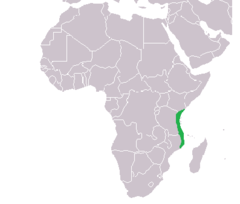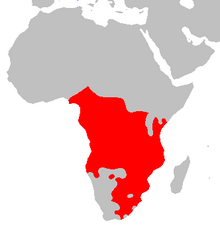Zanj
زنجي, Zanjī; from Persian: زنگ, romanized: Zang)[1][2] is a term used by medieval Muslim geographers to refer to both a certain portion of Southeast Africa (primarily the Swahili Coast) and to its Bantu inhabitants.
[8][9] Anthony Christie argued that the word zanj or zang may not be Arabic in origin: a Chinese form (僧祇 sēngqí) is recorded as early as 607 AD.
Arab and Chinese sources referred to the general area that was located to the south of the three regions of Misr (Egypt), Al-Habasha (Abyssinia) and Barbara (Somalia), as Zanj.
[3][15][16] The core area of Zanj occupation stretched from the territory south of present-day Ras Kamboni[17] to Pemba Island in Tanzania.
[18][19] The 10th-century Arab historian and geographer Abu al-Hasan 'Alī al-Mas'ūdī describes Sofala as the furthest limit of Zanj settlement, and mentions its king's title as Mfalme, a Bantu word.
[3] The settlements in Zanzibar identified them as economically part of the cosmopolitan culture of the Indian Ocean Basin with trade links as far as Arabia, Persia, and as far east as India and China.
[23] Prominent settlements of the Zanj coast included Kilwa, Kunduchi, Mbuamaji, Tongoni, Kimbiji, Kaole, Malindi, Gedi, and Mombasa.
[citation needed] The urban ruling and commercial classes of these Swahili settlements included male Arab, Persian, and Indian immigrants.
However, Islamic culture prized familial origins from Persia or Arabia; consequently claims of Middle Eastern descent may be untrustworthy for modern genealogical research.
[23][24][25] The richest and most powerful slave trader in all of recorded history is Tippu Tip, a man born in Zanzibar with mixed Bantu and Omani ancestry.
[26] Samples were taken from two boxes of human remains located the in British Institute in Eastern Africa (BIEA) in Nairobi, originally excavated in the 1950s and 1960s by Chittick.
Chinese sources from the 9th century make a clear distinction between "Somali (Barbar) pastoralists of Po-Pa-Li" and "savage blacks of Ma-Lin," which is probably to be identified with Malindi in Kenya.
He frequently makes raids into the Zanj country [neighboring mainland], attacks them and carries off booty, of which he reserves a fifth, using it in the manner prescribed by the Koran [Qur'an].
[33]The Zanj Rebellion was a series of uprisings that took place between 869 and 883 AD near the city of Basra in present-day Iraq during slavery in the Abbasid Caliphate.
To equate Negro with slave is a reflection of nineteenth-century racial theories; it could only apply to the American South before the Civil War...On the contrary, some of the people who were working in the salt marshes were among the first to fight against the revolt.
The vast majority of the rebels were Arabs of the Persian Gulf supported by free East Africans who had made their homes in the region.




